Geoblog.pl  bzmot
bzmot  Podróże
Podróże  Łosie okrakiem przez Amerykę - V2.0 - The Moose Do America Again - Click Here!!!
Łosie okrakiem przez Amerykę - V2.0 - The Moose Do America Again - Click Here!!!  Z kamerą wśród zwierząt/All creatures big and small
Z kamerą wśród zwierząt/All creatures big and small
 bzmot
bzmot  Podróże
Podróże  Łosie okrakiem przez Amerykę - V2.0 - The Moose Do America Again - Click Here!!!
Łosie okrakiem przez Amerykę - V2.0 - The Moose Do America Again - Click Here!!!  Z kamerą wśród zwierząt/All creatures big and small
Z kamerą wśród zwierząt/All creatures big and small 
2007
18
cze
Z kamerą wśród zwierząt/All creatures big and small
Na obrazki się już napatrzyliście, więc teraz trochę komentarza. Kiedy w Buenos temperatura spadła poniżej naszego progu odporności, zarządziliśmy odwrót na północ. Wyskoczyliśmy jeszcze z wizytą do kolegi w Montevideo i nawet załapaliśmy się na ostatni ciepły dzień, ale i stamtąd zwiewaliśmy jak niepyszni, kiedy dogoniła nas fala polarnego chłodu. Za radą starego znajomego Pabla wybraliśmy się do argentyńskiego odpowiednika Pantanalu czyli do Esteros de Iberá. To takie mokradła i jeziorka, dość dziewicze jeszcze, bo od niedawna odwiedzane przez turystów. W dzień kiedy obraliśmy kierunek było tam 30 stopni, ale zapowiadali radykalne ochłodzenie. Nic to, byle wreszcie ruszyć w drogę. Bazą do zwiedzania mokradeł jest Colonia Carlos Pellegrini, dokąd dojeżdża się z Mercedes, niedużego miasta, które ma, o dziwo, bezpośrednie połączenie z Buenos i to w coche cama. Szkoda tylko, że na dojazd do samej wioski traci się cały dzień. W Mercedes jest się z samego rana, a potem autobus lokalny przyjeżdża dopiero o 13 (i jedzie 3-4 godziny). My wsiedliśmy w następny (i zarazem ostatni) o 15, bo i tak tego dnia byśmy nic nie zdążyli obejrzeć, a przynajmniej trochę się do sieci mogliśmy przyssać. Do tego grata co dowozi do wioski radzimy zabrać ciepłe śpiwory. Przynajmniej dowożą cię pod wskazany adres, nie trzeba się po ciemku błąkać. Szczególnie ważne jest to w drodze powrotnej, bo z niewiadomych przyczyn autobusy wyjeżdżają w środku nocy o 3.30 i 4.30, ale wcześniej robią półgodzinną rundkę po całej wiosce, zbierając chętnych z kolejnych pensjonatów. Zainstalowaliśmy się w bardzo przyjemnym i tanim residencialu San Cayetano. Wracam od gospodyni do pokoju, pukam, żeby mi Łoś otworzył, a tam ładniutki Latynos mi otwiera. Ups, sorry. Uciekam do pokoju obok, a zaraz słyszę: hej, nie chcecie mate? Chodźcie na mate. I tak poznajemy Hectora i jego urodziwych synów. Mówią, że są rolnikami i wracają z pracy z sąsiedniej prowincji. Hihi, ale w toku rozmowy okazuje się, że ta praca to we własnym gospodarstwie, a właściwie jednym z wielu. I chyba nie fizyczna, tylko raczej doglądanie innych. Chłopaki zabierają nas swoim jeepem na nocne safari. Udaje nam się przydybać w krzakach kapibarę i jelenia, a Łoś dogłębnie, bo po kolana, zapoznaje się z bagienkiem. Niebo od gwiazd tak upstrzone, że trudno znajome konstelacje rozpoznać. Następnego dnia nieoczekiwanie wychodzi słońce, więc gospodyni zamawia nam wycieczkę po jeziorze. Razem z dwiema innymi osobami zabieramy się małą łódeczką. Już od progu wita nas scenka jak z broszurki Świadków Jehowy. Po lewej wygrzewa się aligatorek, pośrodku jakieś czaple, a zaraz obok pomyka jelonek. A właściwie nie pomyka, tylko gramoli się przez bagienko, jakby w zwolnionym tempie. Słodko wyglądał, tak pierdołowato. My sobie stoimy i zdjęcia pstrykamy, a zwierzaki trzy-cztery metry od nas w ogóle uwagi na nas nie zwracają. Potem do aligatorów podpływaliśmy nawet na metr i też nic. A do kapibarek to podeszliśmy tak, że pogłaskać by się dało. Już zaczęliśmy podejrzewać, że zwierzaki są wypchane i sterowane pilotem. Po zejściu na ląd poszliśmy jeszcze do małpiego gaju, ale nam argentyńscy emeryci wszystkie małpy wypłoszyli. Już mieliśmy wracać, a tu się okazuje, że autobus kursuje co dwa dni. Ups. Ale wioseczka jest tak sielska, że nie zmartwiliśmy się nadto. Założono ją jakieś dziesięć lat temu, jak to w Argentynie bywa, od zera, z myślą o turystach. Mieszkańców na razie garstka, ale typowa siatka prostopadłych ulic już przemyślnie wytyczona. Jest jakieś dziesięć ulic na dziesięć, ale wiele parceli pustką świeci. Od typowego argentyńskiego miasteczka wioska różni się za to nazwami ulic. Nie ma wszechobecnych bohaterów i prezydentów ani nazw prowincji, tylko same nazwy w języku guarani. Bardzo melodyjne, ale trudne do spamiętania.
Jeszcze przyjemniej musi być w cieplejszej porze, ale za to zwierzaki podobno chowają się od upału w wodzie. My od upału na pewno chować się nie będziemy. Wręcz przeciwnie, jedziemy mu na spotkanie.
When the temperature in Buenos Aires dropped below our tolerance threshold, we decided to run north. We just paid a short visit to a friend in Montevideo and even caught the last warm day but even from there we had to beat a hastily retreat when the polar cold was upon us. Taking advice from an old friend, Pablo, we headed for the Argentinian equivalent of Pantanal, or to Esteros de Iberá. These are swamps and lakes, still quite virgin as it has just recently been discovered for tourists. On the day we decided to go there, the temperature was 30 degrees C but a wave of cold was expected. Whatever, let’s hit the road anyway. The base fo visiting the swamps is Colonia Carlos Pellegrini which can be reached from Mercedes, a town which, surprisingly, has a direct connection with Buenos Aires, by coche cama, to boot. It’s a pity, though, that you lose whole day getting to the colony itself. You get to Mercedes first thing in the morning and then a local bus leaves at one p.m. (and takes 3-4 hours). We got on the next one (and the last one) at 3 p.m. as we wouldn’t see anything that day so let’s at least do some Internet stuff. Boarding the old junk that takes you to the village, you’ll be well off taking sleeping bags with you. At least they drop you at the indicated address so you don’t get lost in the dark. This is of special importance going back, as for unknown reasons the buses leave at night: 3.30 and 4.30, but first go around the village, taking passengers from pensions. We found a nice and cheap residencial San Cayetano. After a chat with the landlady, I get back to the room, knock on the door and a cute Latino guy is standing there. Oops, sorry. I run to the room next door and I hear: hey, don’t you want some mate? Come drink mate. This is how we meet Hector and his good-looking sons. They say they are farners and are coming back from work in the neighboring province. Well, as the conversation progresses, we come to understand the farm is their own, one of many, and the work consists in supervising others rather than getting their hands dirty. Guys take us on a night safari in their jeep. We get a capybara and deer sighting and the Moose makes a deep (knee-deep) acquaintance with the swamp. The sky is so full of stars that we can’t recognize the familiar constellations. On the next day, sun comes out so the landlady books a tour for us. With two other people we get on a small boat. No sooner than we leave, we bump into a scene like from a Jehovah Witnesses’ leaflet. On the left, an alligator is sunbathing, in the middle you have some herons and here a little deer is prancing around. Well, not prancing really, but rather wading through the swamp with difficulty as if in slow motion. It looked so cute, so clumsy. We just stand there and take picture after picture, with the animals 3-4 meters away paying no attention whatsoever to the intruders. Then we come closer to the alligators, a meter away and still they’re unphased. We get so close to capybaras that we could easily stroke them on the heads. At one point we suspect they are remote control operated stuffed animals. Once back on land, we go to a monkey grove, but the Argentinian pensioners have already scared all the monkeys away. We are planning to get back but it turns out the bus leaves every other day. Oops. The village is so idyllic, though, that we don’t mind much. It was established some ten years ago, from scratch, as it happens in Argentina, with tourists in mind. There’s a handful of residents so far, but the all-Argentinian grid of perpendicular streets is already there. There are ten streets in both directions but many plots are still empty. What is different about the village is the street names. No presidents or heros or province names, just Guarani words. They’re very melodic sounds but not easy to remember.
It must be even nicer at warmer times, but we hear that the animals hide in the water from the heat. We will surely not hide from the heat. The other way round – here we are running to meet it.
Jeszcze przyjemniej musi być w cieplejszej porze, ale za to zwierzaki podobno chowają się od upału w wodzie. My od upału na pewno chować się nie będziemy. Wręcz przeciwnie, jedziemy mu na spotkanie.
When the temperature in Buenos Aires dropped below our tolerance threshold, we decided to run north. We just paid a short visit to a friend in Montevideo and even caught the last warm day but even from there we had to beat a hastily retreat when the polar cold was upon us. Taking advice from an old friend, Pablo, we headed for the Argentinian equivalent of Pantanal, or to Esteros de Iberá. These are swamps and lakes, still quite virgin as it has just recently been discovered for tourists. On the day we decided to go there, the temperature was 30 degrees C but a wave of cold was expected. Whatever, let’s hit the road anyway. The base fo visiting the swamps is Colonia Carlos Pellegrini which can be reached from Mercedes, a town which, surprisingly, has a direct connection with Buenos Aires, by coche cama, to boot. It’s a pity, though, that you lose whole day getting to the colony itself. You get to Mercedes first thing in the morning and then a local bus leaves at one p.m. (and takes 3-4 hours). We got on the next one (and the last one) at 3 p.m. as we wouldn’t see anything that day so let’s at least do some Internet stuff. Boarding the old junk that takes you to the village, you’ll be well off taking sleeping bags with you. At least they drop you at the indicated address so you don’t get lost in the dark. This is of special importance going back, as for unknown reasons the buses leave at night: 3.30 and 4.30, but first go around the village, taking passengers from pensions. We found a nice and cheap residencial San Cayetano. After a chat with the landlady, I get back to the room, knock on the door and a cute Latino guy is standing there. Oops, sorry. I run to the room next door and I hear: hey, don’t you want some mate? Come drink mate. This is how we meet Hector and his good-looking sons. They say they are farners and are coming back from work in the neighboring province. Well, as the conversation progresses, we come to understand the farm is their own, one of many, and the work consists in supervising others rather than getting their hands dirty. Guys take us on a night safari in their jeep. We get a capybara and deer sighting and the Moose makes a deep (knee-deep) acquaintance with the swamp. The sky is so full of stars that we can’t recognize the familiar constellations. On the next day, sun comes out so the landlady books a tour for us. With two other people we get on a small boat. No sooner than we leave, we bump into a scene like from a Jehovah Witnesses’ leaflet. On the left, an alligator is sunbathing, in the middle you have some herons and here a little deer is prancing around. Well, not prancing really, but rather wading through the swamp with difficulty as if in slow motion. It looked so cute, so clumsy. We just stand there and take picture after picture, with the animals 3-4 meters away paying no attention whatsoever to the intruders. Then we come closer to the alligators, a meter away and still they’re unphased. We get so close to capybaras that we could easily stroke them on the heads. At one point we suspect they are remote control operated stuffed animals. Once back on land, we go to a monkey grove, but the Argentinian pensioners have already scared all the monkeys away. We are planning to get back but it turns out the bus leaves every other day. Oops. The village is so idyllic, though, that we don’t mind much. It was established some ten years ago, from scratch, as it happens in Argentina, with tourists in mind. There’s a handful of residents so far, but the all-Argentinian grid of perpendicular streets is already there. There are ten streets in both directions but many plots are still empty. What is different about the village is the street names. No presidents or heros or province names, just Guarani words. They’re very melodic sounds but not easy to remember.
It must be even nicer at warmer times, but we hear that the animals hide in the water from the heat. We will surely not hide from the heat. The other way round – here we are running to meet it.
Komentarze (1)

 Krakadil? No ser...! - 2007-06-20 04:14
Krakadil? No ser...! - 2007-06-20 04:14Hehe, nareszcie treściwy opis :P Te przerośnięte szczurko-dziki to kapibary? Tak coś mi się przypomniało ze Szklarskiego (chiba). Jak chcecie zobaczyć parę innych znajomych zwierzaków, to zajrzyjcie na http://www.sandomierz4b1997.republika.pl/ :-)





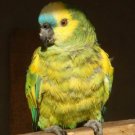
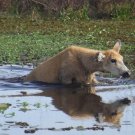
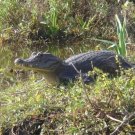

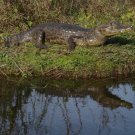
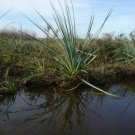

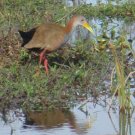

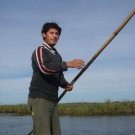
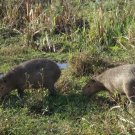

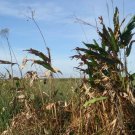
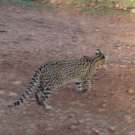

 Zasoby:
Zasoby: 






